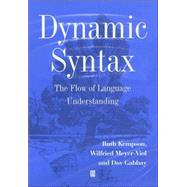
Note: Supplemental materials are not guaranteed with Rental or Used book purchases.
Purchase Benefits
Looking to rent a book? Rent Dynamic Syntax The Flow of Language Understanding [ISBN: 9780631176121] for the semester, quarter, and short term or search our site for other textbooks by Kempson, Ruth; Meyer-Viol, Wilfried; Gabbay, Dov M.. Renting a textbook can save you up to 90% from the cost of buying.
Wilfried Meyer-Viol is Lecturer in the Department of Philosophy at King's College London. He is a logician with a background in psychology who has published on cognitive psychology and on classical, intuitionistic and modal logic.
Dov Gabbay is Professor of Computer Science at King's College London. He is one of the world's foremost authorities on non-classical logics and their applications in computing. He has published over 170 papers and books on this subject, and initiated several currently active research areas in logic and computation.
| Preface | |||||
|
1 | (17) | |||
|
1 | (2) | |||
|
3 | (4) | |||
|
7 | (2) | |||
|
9 | (7) | |||
|
9 | (3) | |||
|
12 | (1) | |||
|
13 | (2) | |||
|
15 | (1) | |||
|
15 | (1) | |||
|
16 | (2) | |||
|
18 | (37) | |||
|
19 | (8) | |||
|
27 | (28) | |||
|
31 | (5) | |||
|
36 | (3) | |||
|
39 | (2) | |||
|
41 | (1) | |||
|
42 | (7) | |||
|
49 | (6) | |||
|
55 | (48) | |||
|
56 | (20) | |||
|
56 | (8) | |||
|
64 | (3) | |||
|
67 | (9) | |||
|
76 | (22) | |||
|
80 | (9) | |||
|
89 | (6) | |||
|
95 | (3) | |||
|
98 | (5) | |||
|
103 | (47) | |||
|
103 | (6) | |||
|
104 | (1) | |||
|
105 | (4) | |||
|
109 | (12) | |||
|
110 | (1) | |||
|
111 | (10) | |||
|
121 | (23) | |||
|
121 | (7) | |||
|
128 | (2) | |||
|
130 | (3) | |||
|
133 | (6) | |||
|
139 | (3) | |||
|
142 | (2) | |||
|
144 | (4) | |||
|
148 | (2) | |||
|
150 | (40) | |||
|
150 | (1) | |||
|
151 | (5) | |||
|
154 | (2) | |||
|
156 | (7) | |||
|
158 | (3) | |||
|
161 | (2) | |||
|
163 | (23) | |||
|
163 | (6) | |||
|
169 | (17) | |||
|
186 | (4) | |||
|
190 | (33) | |||
|
190 | (6) | |||
|
196 | (25) | |||
|
196 | (17) | |||
|
213 | (8) | |||
|
221 | (2) | |||
|
223 | (30) | |||
|
223 | (1) | |||
|
224 | (7) | |||
|
231 | (22) | |||
|
234 | (5) | |||
|
239 | (6) | |||
|
245 | (4) | |||
|
249 | (4) | |||
|
253 | (15) | |||
|
253 | (6) | |||
|
259 | (3) | |||
|
260 | (2) | |||
|
262 | (2) | |||
|
264 | (2) | |||
|
266 | (2) | |||
|
268 | (58) | |||
|
268 | (5) | |||
|
273 | (34) | |||
|
273 | (18) | |||
|
291 | (6) | |||
|
297 | (5) | |||
|
302 | (5) | |||
|
307 | (10) | |||
|
308 | (4) | |||
|
312 | (5) | |||
|
317 | (9) | |||
|
317 | (2) | |||
|
319 | (1) | |||
|
320 | (1) | |||
|
321 | (1) | |||
|
322 | (1) | |||
|
322 | (1) | |||
|
323 | (2) | |||
|
325 | (1) | |||
|
325 | (1) | |||
| Bibliography | 326 | (12) | |||
| General Index | 338 | (9) | |||
| Symbol Index | 347 |
The New copy of this book will include any supplemental materials advertised. Please check the title of the book to determine if it should include any access cards, study guides, lab manuals, CDs, etc.
The Used, Rental and eBook copies of this book are not guaranteed to include any supplemental materials. Typically, only the book itself is included. This is true even if the title states it includes any access cards, study guides, lab manuals, CDs, etc.